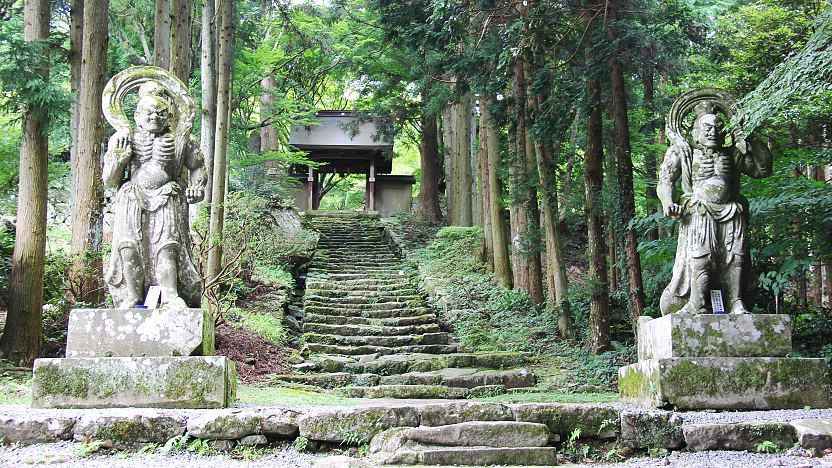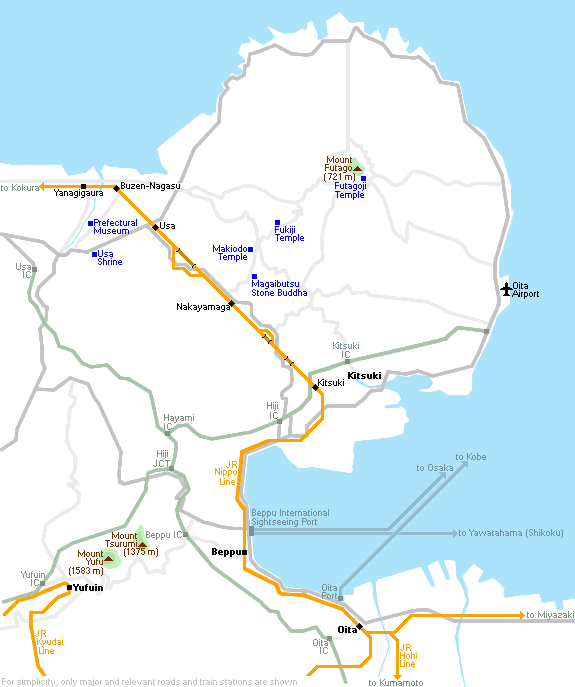Rokugo Manzan Temples

The Kunisaki Peninsula's terrain consists of the 721 meter tall Mount Futago at the center and a series of valleys radiating from it. The region's tranquil countryside is dotted with dozens of temples and some shrines. It was traditionally divided into six areas and known as Rokugo Manzan (六郷満山), which literally means "Six Towns Full Mountain".
The unique local religious culture of Rokugo Manzan contains elements of Buddhism, Shinto and mountain worship, and revolves around the peninsula's numerous temples and Usa Shrine. A noteworthy characteristic of the Rokugo Manzan culture is the predominance of stone statues of Buddhas and other deities and guardians.

Located close to the peak of Mount Futago is Futagoji (両子寺), a prominent temple with a history of more than 1300 years. Futagoji's grounds cover a wide area on the forested slopes of the mountain, with gravel paths and stairs connecting several halls housing various deities.
A pair of stone Nio Guardians stand at the start of the traditional temple approach below the parking lot, from where a ten minute ascent up a flight of steps takes you to the main temple buildings. Among them are the Gomado Hall which is dedicated to Fudomyoo, a protector of Buddhism, and the Okunoin Hall, which enshrines the thousand-armed Kannon Bodhisattva. The more adventurous may climb up a slightly challenging path beyond the temple buildings to see several natural creations such as narrow openings through large rocks.

About 15 kilometers southwest of Futagoji stands Fukiji Temple (富貴寺), whose main hall is a designated national treasure. It is the oldest wooden structure existing in Kyushu, dating back to the late Heian Period (). The simple, beautiful wooden temple building sits serenely with a backdrop of trees, and is featured widely in pamphlets on the Rokugo Manzan area.
Fukiji is dedicated to Amida Buddha, and its main hall houses an intricate wooden statue of the deity. In fact, the hall is ranked as one of the top three Amida Buddha halls in all of Japan, along with Hoodo Hall at Byodoin Temple and the golden Konjikido Hall at Chusonji Temple.

Located just by the main road about five kilometers south of Fukiji Temple is Makiodo (真木大堂, Maki Ōdō), a temple that displays some outstanding, wooden images of Amida Buddha, the four heavenly kings and Fudomyoo in its treasure house. The original temple hall was lost in a fire about 700 years ago, but fortunately the wooden statues were rescued.
Less than five kilometers south of Makiodo are the Kumano Magaibutsu Stone Buddha (熊野磨崖仏), two large stone carvings into the walls of a cliff: an eight meter tall Fudomyoo and a nearly seven meter tall Dainichi Buddha. They are the largest Buddhist stone carvings in Japan, but are not as intricately sculpted as the Usuki Stone Buddhas, as they were carved into harder rock than the ones at Usuki.
It is unknown when exactly these huge stone carvings were made, but it is estimated that they were created during the late Heian Period. In order to see the carvings, visitors have to walk through the forest for about 20-30 minutes first along a gravel path and then along a steep flight of stairs.

Getting there and around
It is very difficult to get to the temples of the Kunisaki Peninsula by public transport because not only do buses run infrequently, but transfers are needed, and there is rarely a suitable connection. The most convenient method to get around is a rental car. Rental car outlets can be found at Oita Airport and in Usa and Beppu.
Alternatively, 2-3 hour long taxi tours are available from Oita Airport. These chartered taxis offer several fixed itineraries which include some of the peninsula's temples. Fees range from 9,000 to 15,000 yen per taxi, which accommodate four to five people. Note that the taxi drivers may not be able to converse in English.
There is also a daily guided bus tour of the Kunisaki Peninsula in Japanese, which covers Usa Shrine and the above mentioned temples. The bus departs from Oita Station and also stops at Beppu and Usa Stations before visiting the various shrines and temples and returning via Oita Airport to Beppu and Oita. The cost is between 3100 and 5700 yen depending on boarding and alighting stations.
How to get to and around the Kunisaki Peninsula

Hours and Fees
Futagoji Temple
Hours
Closed
Admission
Fukiji Temple
Hours
Closed
Admission
Makiodo
Hours
Closed
Admission
Kumano Magaibutsu
Hours
Closed
Admission
Questions? Ask in our forum.


